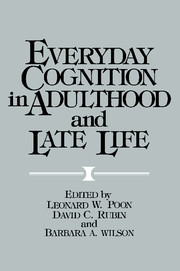Book contents
- Frontmatter
- Contents
- List of contributors
- Preface
- Part I Adult cognitive abilities in the laboratory and in real-life settings: Basic theoretical and methodological issues
- Part IA Systematic approaches to laboratory and real-world research
- Part IB Combining laboratory and real-world research
- Part II Cognition in adulthood and late life: Findings in real-life settings
- Part IIA Everyday cognitive abilities
- 11 Memory for prose: Perspectives on the reader
- 12 Prose processing in adulthood: The text, the reader, and the task
- 13 Speech comprehension and memory through adulthood: The roles of time and strategy
- 14 The effects of aging on perceived and generated memories
- 15 Aging and word retrieval: Naturalistic, clinical, and laboratory data
- 16 Acquisition and utilization of spatial information by elderly adults: Implications for day-to-day situations
- 17 Inner-city decay? Age changes in structure and process in recall of familiar topographical information
- 18 The cognitive ecology of problem solving
- 19 Everyday problem solving: Methodological issues, research findings, and a model
- 20 Prospective/intentional memory and aging: Memory as adaptive action
- Part IIB Concomitant influences
- Part III Cognitive enhancement and aging: Clinical and educational applications
- Part IIIA Issues and perspectives
- Part IIIB Enhancement approaches
- Part IIIC Designing programs for cognitive rehabilitation
- Subject index
- Author index
17 - Inner-city decay? Age changes in structure and process in recall of familiar topographical information
Published online by Cambridge University Press: 05 October 2013
- Frontmatter
- Contents
- List of contributors
- Preface
- Part I Adult cognitive abilities in the laboratory and in real-life settings: Basic theoretical and methodological issues
- Part IA Systematic approaches to laboratory and real-world research
- Part IB Combining laboratory and real-world research
- Part II Cognition in adulthood and late life: Findings in real-life settings
- Part IIA Everyday cognitive abilities
- 11 Memory for prose: Perspectives on the reader
- 12 Prose processing in adulthood: The text, the reader, and the task
- 13 Speech comprehension and memory through adulthood: The roles of time and strategy
- 14 The effects of aging on perceived and generated memories
- 15 Aging and word retrieval: Naturalistic, clinical, and laboratory data
- 16 Acquisition and utilization of spatial information by elderly adults: Implications for day-to-day situations
- 17 Inner-city decay? Age changes in structure and process in recall of familiar topographical information
- 18 The cognitive ecology of problem solving
- 19 Everyday problem solving: Methodological issues, research findings, and a model
- 20 Prospective/intentional memory and aging: Memory as adaptive action
- Part IIB Concomitant influences
- Part III Cognitive enhancement and aging: Clinical and educational applications
- Part IIIA Issues and perspectives
- Part IIIB Enhancement approaches
- Part IIIC Designing programs for cognitive rehabilitation
- Subject index
- Author index
Summary
Until recently, cognitive psychologists had interpreted memory changes in old age in terms of “process” models for information flow. A meticulously detailed exemplar is the “working memory” model first proposed by Baddeley and Hitch (1974) and since extensively developed (Baddeley, Grant, Wight, & Thompson, 1975; Baddeley & Lieberman, 1980). Information from the sense organs is “encoded” into characteristic “representations” in one or more modality-based subsystems (the visual “scratch pad” and the auditory “articulatory loop”). Besides its own characteristic representation code, each of these subsystems has characteristic temporal holding characteristics, which may depend on rate limitations to a dynamic process (the refreshment cycle time of the articulatory loop) or on capacity limitations of unknown provenance (the capacity of the scratch pad). Each subsystem also has its characteristic place in an information-routing diagram for the total “memory system.”
In this framework, the study of cognitive aging has become an investigation of the differential vulnerability of subsystems and of their linkages. Thus, among other excellent recent reviews, Erber (1982) discusses changes in the efficiency of “sensory memory,” “primary memory,” “secondary memory,” and dynamic read-in and read-out processes (encoding and retrieval). Kausler (1982) uses a similar “bottom-up” hierarchical description of changes in hypothetical “primary memory” and “episodic memory” systems. Craik (1976) suggests a framework for interpreting age changes in memory in terms of a hierarchical scheme of progressively “deeper” processing stages.
- Type
- Chapter
- Information
- Everyday Cognition in Adulthood and Late Life , pp. 284 - 299Publisher: Cambridge University PressPrint publication year: 1989
- 2
- Cited by



